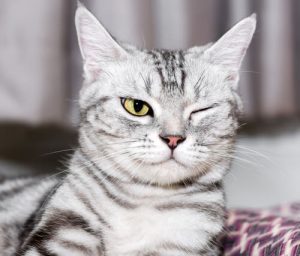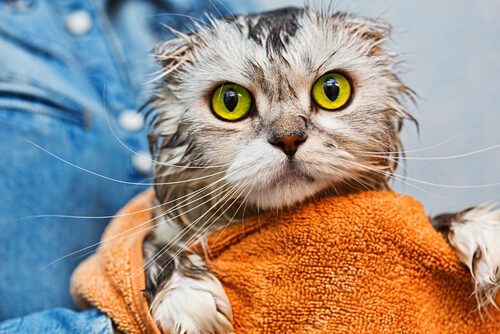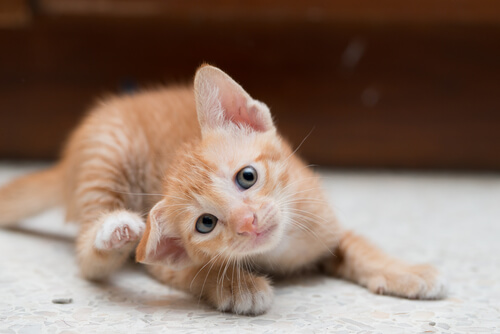Eye Diseases in Cats: prevention and care

Eye Diseases in Cats
You may have noticed that some stray cats have cloudy eyes or one that’s closed more than the other. Well, it happens because it’s relatively common for cats to contract an eye disease.
Sometimes, this can be a symptom of a serious underlying disease that can threaten your cat’s health. So, you should read this article to learn how to recognize and prevent eye diseases in your cat so they can be as healthy as possible.
Warning Signs: how to detect and prevent future symptoms
A periodic examination in the comfort of your home can be one of the best ways to keep your cat’s eyes healthy. You can do these routine inspections, while you are grooming your cat.

In order to properly check for any change in their eyes, use your thumb to carefully left the eyelid and inspect the surrounding area. It should have a pink tone that’s not reddish or whitish.
The most common warning signs that can be indications of eye diseases in cats are:
- White secretions
- Excess water in eyes
- Red or whitish tissue around the eyelids
- Crusty and dry residue in the corner of the eye
- Hair stained with tears
- One or both eyes closed
- Cloudy vision or change in the color of his eyes
- Occasionally, an easily noticeable third eyelid
Your cat’s body language may also offer some clues about the state of his eyes. If the animal scratches his eye area too much or starts to look more clumsy than usual, it may be because of an eye problem.

Types of diseases your cat get
The most common eye diseases among cats are the following:
- Conjunctivitis. This is a disease caused by the inflammation of the conjunctiva. This is the thin, transparent tissue that lines the inside of the eyelid and the white part of the eye. If your pet’s eyes swell, becomes bloodshot, and secretes liquids, it’s likely that your cat has some sort of pink eye.
- Protrusion of the third eyelid. Many animals naturally develop a third eyelid as a way to defend themselves against possible infections. When it swells, it’s likely that your pet has contracted another underlying disease.
- Keratitis. This is the inflammation of the cornea and it can develop due to multiple causes.
- Glaucoma. In this case, the liquid pressure in the eyes naturally increases until the optic nerve is damaged. One of the most common signs is the cornea becoming clouded and the eye growing abnormally, which is caused by having a lot of pressure on the eye socket.
- Trauma in the eye is caused by fights or accidents.
- Clogged tear glands are caused by excessive secretion or disease-related swelling.
Prevention and Treatment
You’d be surprised to know how much you can improve your cat’s eye health with a simple wipe that is specially made for cleaning excess crust that your cat naturally produces.
Cats are neat animals. In general, that is a good habit that helps prevent infections and diseases. However, if your pet contracts any of the diseases listed above, don’t hesitate to visit your vet. He or she will prescribe drops and the appropriate medicine.
Eye Diseases in Cats
You may have noticed that some stray cats have cloudy eyes or one that’s closed more than the other. Well, it happens because it’s relatively common for cats to contract an eye disease.
Sometimes, this can be a symptom of a serious underlying disease that can threaten your cat’s health. So, you should read this article to learn how to recognize and prevent eye diseases in your cat so they can be as healthy as possible.
Warning Signs: how to detect and prevent future symptoms
A periodic examination in the comfort of your home can be one of the best ways to keep your cat’s eyes healthy. You can do these routine inspections, while you are grooming your cat.

In order to properly check for any change in their eyes, use your thumb to carefully left the eyelid and inspect the surrounding area. It should have a pink tone that’s not reddish or whitish.
The most common warning signs that can be indications of eye diseases in cats are:
- White secretions
- Excess water in eyes
- Red or whitish tissue around the eyelids
- Crusty and dry residue in the corner of the eye
- Hair stained with tears
- One or both eyes closed
- Cloudy vision or change in the color of his eyes
- Occasionally, an easily noticeable third eyelid
Your cat’s body language may also offer some clues about the state of his eyes. If the animal scratches his eye area too much or starts to look more clumsy than usual, it may be because of an eye problem.

Types of diseases your cat get
The most common eye diseases among cats are the following:
- Conjunctivitis. This is a disease caused by the inflammation of the conjunctiva. This is the thin, transparent tissue that lines the inside of the eyelid and the white part of the eye. If your pet’s eyes swell, becomes bloodshot, and secretes liquids, it’s likely that your cat has some sort of pink eye.
- Protrusion of the third eyelid. Many animals naturally develop a third eyelid as a way to defend themselves against possible infections. When it swells, it’s likely that your pet has contracted another underlying disease.
- Keratitis. This is the inflammation of the cornea and it can develop due to multiple causes.
- Glaucoma. In this case, the liquid pressure in the eyes naturally increases until the optic nerve is damaged. One of the most common signs is the cornea becoming clouded and the eye growing abnormally, which is caused by having a lot of pressure on the eye socket.
- Trauma in the eye is caused by fights or accidents.
- Clogged tear glands are caused by excessive secretion or disease-related swelling.
Prevention and Treatment
You’d be surprised to know how much you can improve your cat’s eye health with a simple wipe that is specially made for cleaning excess crust that your cat naturally produces.
Cats are neat animals. In general, that is a good habit that helps prevent infections and diseases. However, if your pet contracts any of the diseases listed above, don’t hesitate to visit your vet. He or she will prescribe drops and the appropriate medicine.
All cited sources were thoroughly reviewed by our team to ensure their quality, reliability, currency, and validity. The bibliography of this article was considered reliable and of academic or scientific accuracy.
- Stiles, J. (1995). Treatment of cats with ocular disease attributable to herpesvirus infection: 17 cases (1983-1993). Journal of the American Veterinary Medical Association, 207(5), 599-603.
- La Croix, N. C. (2005). Ocular manifestations of systemic disease in cats. Clinical techniques in small animal practice, 20(2), 121-128.
- Cunningham Jr, E. T., & Koehler, J. E. (2000). Ocular bartonellosis. American journal of ophthalmology, 130(3), 340-349.
This text is provided for informational purposes only and does not replace consultation with a professional. If in doubt, consult your specialist.








